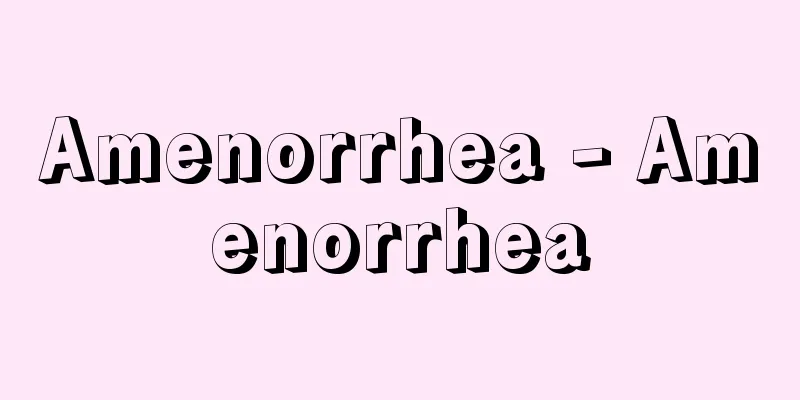Amenorrhea - Amenorrhea

|
[What kind of disease is it?] Menstruation is defined as the periodic bleeding from the uterine lining that usually occurs at monthly intervals and stops naturally after a limited number of days. At first glance, this may seem to be caused by the uterus alone, but in reality, it is a phenomenon that occurs in cooperation with the hypothalamus, pituitary gland, ovaries, and uterus. When this coordination is broken and menstruation stops, the condition is called amenorrhea. Amenorrhea is classified into primary amenorrhea, where a woman has not had her first menstruation by the age of 18 or later, and secondary amenorrhea, where a woman has not had menstruation for three months or more despite having had menstruation until then. ■Causes of primary amenorrhea include when the chromosomes are different from those of normal women, such as Turner syndrome, where there is a sex chromosome abnormality and the ovaries are present but do not contain follicles, resulting in amenorrhea; or when the sex tubes do not differentiate normally during fetal development, resulting in the absence of a uterus or vagina, which causes the vagina to close and menstrual blood to not be expelled from the body. In addition, a woman may not experience menarche because she is in an environment that causes secondary amenorrhea. ■Secondary amenorrhea is a condition in which parts of the organs (hypothalamus, pituitary gland, ovaries, and uterus) that previously worked together in harmony are now damaged. ● Amenorrhea caused by the hypothalamus This accounts for 80-85% of secondary amenorrhea. The hypothalamus controls the function of the ovaries through the pituitary gland, but also responds to the follicle hormone secreted by the ovaries and regulates the secretion of substances that promote the release of hormones. Amenorrhea caused by causes in the hypothalamus includes stress-related amenorrhea caused by severe mental stress, weight-loss-related amenorrhea caused by sudden weight loss, amenorrhea caused by extreme food intake such as anorexia nervosa and bulimia, and exercise-related amenorrhea caused by excessive exercise. In addition, there are many cases of idiopathic hypothalamic amenorrhea that occur without any of the above-mentioned causes. In addition, there is also functional hyperprolactinemia, in which the hormone prolactin, which stimulates milk secretion but is normally suppressed by the hypothalamus, is secreted in excess due to decreased function of the hypothalamus, resulting in amenorrhea. Amenorrhea caused by the pituitary gland This accounts for 4-6% of secondary amenorrhea. In addition to secreting hormones that directly stimulate the ovaries, the pituitary gland also secretes hormones that stimulate the adrenal cortex and thyroid gland, as well as prolactin. When a tumor develops in the pituitary gland, especially when a tumor that produces prolactin develops, it is called galactorrhea. In addition, there are also cases where amenorrhea occurs due to heavy bleeding during childbirth, which causes the pituitary gland to lose its function (Sheehan syndrome (Column "Sheehan Syndrome")). ● Amenorrhea due to ovarian causes This accounts for 5 to 9% of secondary amenorrhea. The functions of the ovaries are ovulation and the secretion of ovarian hormones (follicle-stimulating hormone and luteinizing hormone). Due to the action of hormones secreted from the pituitary gland that stimulate the ovaries (follicle-stimulating hormone and luteinizing hormone), eggs grow into follicles and ovulation occurs, but if the balance of these two hormones is disrupted, ovulation cannot occur. As this process is repeated, many cysts form in the ovaries, making it even more difficult for them to receive commands from the pituitary gland. This condition is called polycystic ovary syndrome, and is a typical example of ovarian amenorrhea. Amenorrhea can also occur if tumors that produce male or female hormones develop in the ovaries. ●Amenorrhea due to uterine causes This accounts for 1-3% of cases of secondary amenorrhea. Menstruation is bleeding from the uterine lining. If there is a disorder in the uterine lining, for example after repeated abortion curettage or cesarean section, the uterine cavity may become adherent and cause amenorrhea (Asherman's syndrome). ●Other causes Amenorrhea can also occur when your overall health is impaired, for example, if the thyroid or adrenal glands are overactive, or if you have diabetes or kidney failure. Also, certain medications can cause amenorrhea, so if you are taking any medications for a long period of time, you should consult your doctor. [Treatment] Currently, more than 95% of women experience their first menstruation by age 15. If a girl has not had her first menstruation by age 16, it is a good idea to see a gynecologist. As a result, if you are diagnosed with primary amenorrhea and abnormalities in your chromosomes or reproductive tract are found, unfortunately there is no fundamental treatment and symptomatic treatment is required. Vaginal atresia can be cured by incision. On the other hand, if you are diagnosed with secondary amenorrhea, the treatment will vary depending on the cause and your age. Since amenorrhea that continues for a long period of time can have a negative effect on the lining of the uterus, you should consult a specialist and consider treatment. However, for a while after menarche, the ovarian function is still immature, so the progress will be monitored. Other than that, the first step is to identify the cause and then remove it. If amenorrhea persists despite this, excluding cases where the cause is in the uterus, hormone therapy (column "Hormone replacement therapy for treating amenorrhea") will be performed to make up for any deficiencies compared to a normal menstrual cycle using two types of sex hormones (follicle-stimulating hormone and progesterone) secreted by the ovaries. Other options include clomiphene therapy, which stimulates the hypothalamus to induce ovulation, and the treatment that is chosen will depend on each individual's symptoms. However, in the case of infertility, different treatments are required. For psychogenic amenorrhea, it is important to also seek psychological counseling, lead a regular life, exercise moderately, and pay attention to your diet. For uterine amenorrhea, hormone therapy is administered to remove adhesions in the lining and prevent them from forming again. However, there are exceptions to the rule that do not require treatment: physiological amenorrhea (before menarche, after menopause, during pregnancy, the puerperium, and during lactation). Source: Shogakukan Home Medical Library Information |
|
[どんな病気か] 月経とは、通常1か月の間隔でおこり、限られた日数で自然に止まる子宮内膜(しきゅうないまく)からの周期的出血、と定義されています。これは一見、子宮のはたらきだけでおこっているようにみえますが、実際は、視床下部(ししょうかぶ)、下垂体(かすいたい)、卵巣(らんそう)、子宮が、すべて協調しあって発生する現象です。 この協調がくずれ、月経がみられなくなる状態を、無月経といいます。 無月経は、18歳以後になっても初潮(しょちょう)のみられない原発性無月経(げんぱつせいむげっけい)と、月経がそれまであったにもかかわらず、3か月以上みられなくなる続発性無月経(ぞくはつせいむげっけい)に分類されます。 ■原発性無月経 原因には、染色体が正常な女性のものと異なっている場合、たとえばターナー症候群(「ターナー症候群」)のように性染色体異常があって、卵巣(らんそう)はあっても卵胞(らんぽう)成分を含まないため無月経になる場合や、胎児期に性管が正常に分化できず子宮や腟(ちつ)がない場合、腟が閉鎖して月経血が体外に排出されない場合があります。 また、続発性無月経がおこる環境にあるために、初潮がみられない場合もあります。 ■続発性無月経 以前には協調しあっていた各臓器(視床下部・下垂体・卵巣・子宮)の一部分が、障害されてしまった状態です。 ●視床下部に原因のある無月経 続発性無月経の原因の80~85%を占めます。視床下部は、下垂体を介して卵巣のはたらきをコントロールする反面、卵巣から分泌(ぶんぴつ)される卵胞ホルモンに反応し、ホルモンの放出を促進する物質の分泌を調節しています。 視床下部に原因のある無月経には、強い精神的ストレスによっておこるストレス性無月経、急激な体重減少によっておこる体重減少性無月経、極端な食物の摂取異常、たとえば神経性食欲不振症(しんけいせいしょくよくふしんしょう)や過食症(かしょくしょう)による無月経、過度の運動によっておこる運動性無月経などがあります。 また、前記のような原因が何もないのにおこる特発性視床下部性無月経も少なくありません。 そのほかに、ふだんは視床下部によって抑制されている乳汁(にゅうじゅう)の分泌をうながすプロラクチンというホルモンが、視床下部のはたらきが低下することによって過剰に分泌され、このホルモンが原因で無月経になる機能的高プロラクチン血症もあります。 ●下垂体に原因のある無月経 続発性無月経の原因の4~6%を占めます。下垂体は、直接的に卵巣を刺激するホルモンを分泌するほかに、副腎皮質(ふくじんひしつ)や甲状腺(こうじょうせん)を刺激するホルモンと、プロラクチンなどを分泌しています。 下垂体に腫瘍(しゅよう)ができた場合、とくにプロラクチンをつくり出す腫瘍ができた場合を、乳汁漏出性無月経(にゅうじゅうろうしゅつせいむげっけい)といいます。また、分娩(ぶんべん)の際、大量に出血し、下垂体に血液がいかず、下垂体の機能がなくなって無月経になってしまう場合(シーハン症候群(しょうこうぐん)(コラム「シーハン症候群」))もあります。 ●卵巣に原因のある無月経 続発性無月経の原因の5~9%を占めます。 卵巣のはたらきは、排卵(はいらん)と、卵巣ホルモン(卵胞ホルモンと黄体(おうたい)ホルモン)の分泌です。 下垂体から分泌される卵巣を刺激するホルモン(卵胞刺激ホルモンと黄体化ホルモン)の作用により、卵(らん)は育って卵胞となり、排卵がおこりますが、この2つのホルモンのバランスがくずれると、排卵ができなくなります。そして、こうしたことをくり返すうちに、卵巣の中にたくさんの嚢胞(のうほう)ができて、下垂体の指令をさらに受けにくくなってしまいます。このような状態を多嚢胞性卵巣(たのうほうせいらんそう)といい、卵巣性無月経の代表的な病気です。 また、卵巣に、男性ホルモンや女性ホルモンをつくり出す腫瘍ができても無月経になります。 ●子宮に原因のある無月経 続発性無月経の原因の1~3%を占めます。 月経は、子宮内膜からの出血です。子宮内膜に障害がある場合、たとえば、くり返し行なった妊娠中絶の掻爬(そうは)手術や、帝王切開術(ていおうせっかいじゅつ)の後、子宮内腔(しきゅうないくう)が癒着(ゆちゃく)して無月経になる場合(アッシャーマン症候群)があります。 ●その他の原因 全身の健康状態がくずれたとき、たとえば、甲状腺や副腎の機能が亢進(こうしん)している場合や、糖尿病、腎不全(じんふぜん)でも無月経になります。 また、特定の薬によって無月経になる場合もありますので、長期的に内服している薬があるときには、医師に相談してみる必要があります。 [治療] 初潮は、現在では15歳までに95%以上の人でみられます。16歳になっても初潮がみられない場合は、婦人科の診察を受けたほうがよいでしょう。 その結果、原発性無月経と診断され、染色体や性管に異常があることがわかった場合には、残念ながら根本的な治療法はなく、対症的な治療が必要となります。なお、腟閉鎖は切開することによって治ります。 一方、続発性無月経と診断された場合の治療は、原因によっても、年齢によっても異なります。無月経の状態が長期間続くことは、子宮の内膜にとって悪い影響をもたらしますので、専門医に相談し、治療を考える必要があります。 しかし、初潮後しばらくは、卵巣の機能が未熟なので、経過を観察していくことになります。それ以外は、まず原因を明らかにして、原因を取り除くことから始めます。 それでも無月経が続く場合には、子宮に原因があるものを除いて、卵巣から分泌する2種類の性ホルモン(卵胞ホルモンと黄体ホルモン)で、正常の月経周期と比べて足りないものを補うホルモン療法(コラム「無月経治療のためのホルモン補充療法」)を行ないます。 このほか、視床下部に刺激を加えて排卵をうながすクロミフェン療法などがあり、それぞれの症状に応じた選択をしていくことになります。 ただし、不妊症の場合には、これらとは異なった治療を行なう必要があります。 心因性無月経には、精神的なカウンセリングを併用したり、規則正しい生活、適度な運動、食生活の注意をしていくこともたいせつです。 子宮性無月経は、内腔の癒着を剥離(はくり)して、再癒着しないように、ホルモン療法を行ないます。 なお、例外として、治療を必要としない無月経に、生理的無月経(初経以前、閉経後、妊娠中、産褥期(さんじょくき)、授乳期)があります。 出典 小学館家庭医学館について 情報 |
<<: Infinity - Mugen (English spelling) infinity English
>>: Mugegawa [town] - Mugegawa
Recommend
Breast mirror - escutcheon
When you look at a dairy cow from behind, you can ...
Recoverable reserves - Recoverable reserves
The amount that can be economically and technicall...
Bowen's disease
...The lesions are pale pink and scaly, with the ...
Gymnastike - Gymnastike
… [Europe] In ancient Greece, festivals such as t...
Fragments of Papias - Papias's fragments
A document included in the Apostolic Fathers. Papi...
Diuretics
Diuretics. A drug that promotes urine production ...
Adapidae
...In the Eocene, North America and Europe became...
Sorsa, K. (English spelling) SorsaK
…Official name: Republic of FinlandSuomen Tasaval...
Angraecum sesquipedale (English spelling) Angraecum sesquipedale
…[Koichi Ejiri]. . . *Some of the terminology tha...
Kingdom of Dahomey - Kingdom of Dahomey
The kingdom of the Fon people once flourished in t...
Overborrowing - Overborrowing (English spelling)
In terms of corporate financing, this refers to a...
Volatile oil - Kihatsuyu
An oil with a low boiling point obtained by fracti...
Kabutoya - Kabutoya
...The Tokyo Art Club has clubs in Tokyo, Osaka, ...
kingbird
…In most cases, the female incubates the eggs, an...
Inconvertible paper money
Paper money that is not convertible into specie (s...









